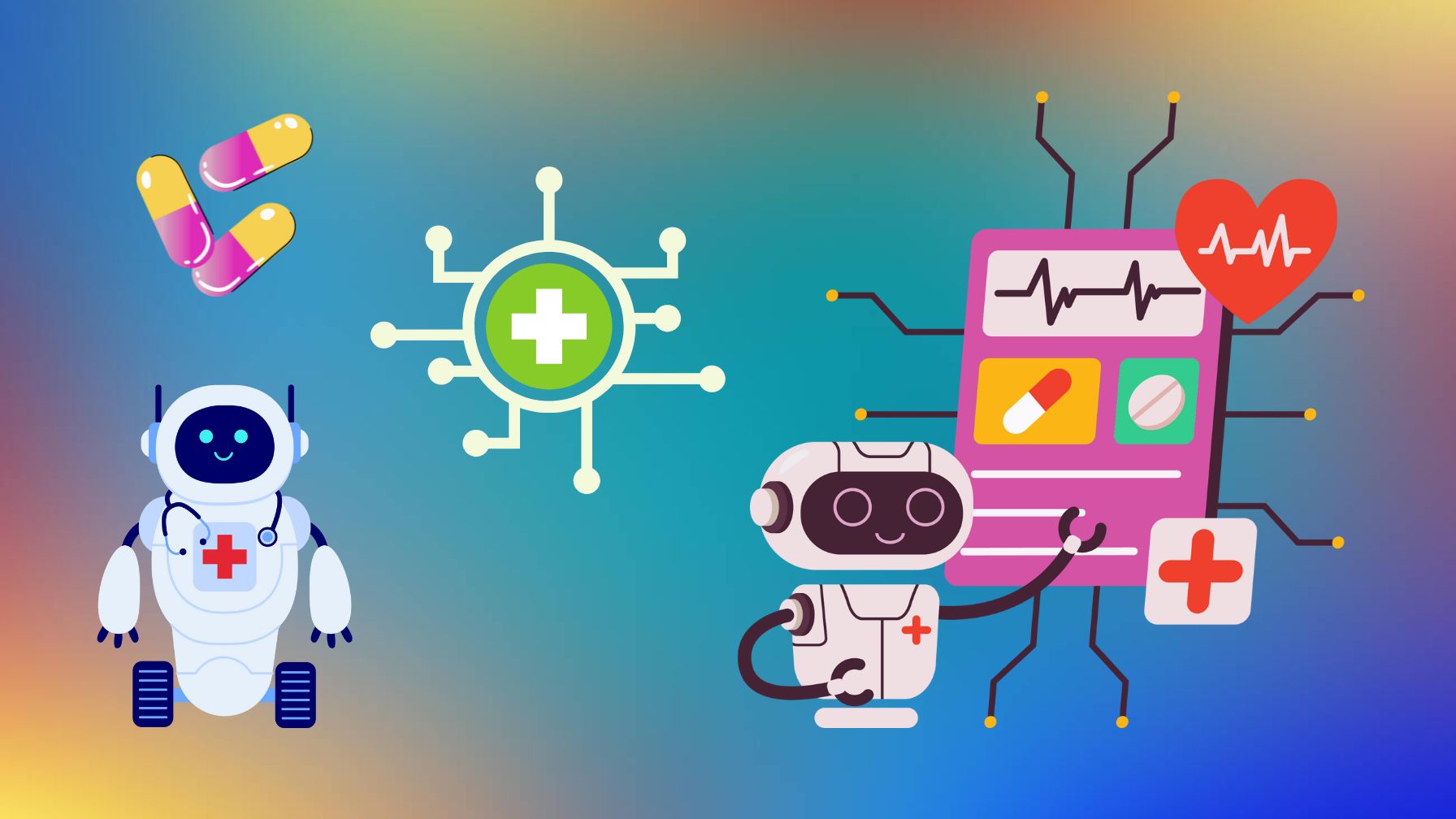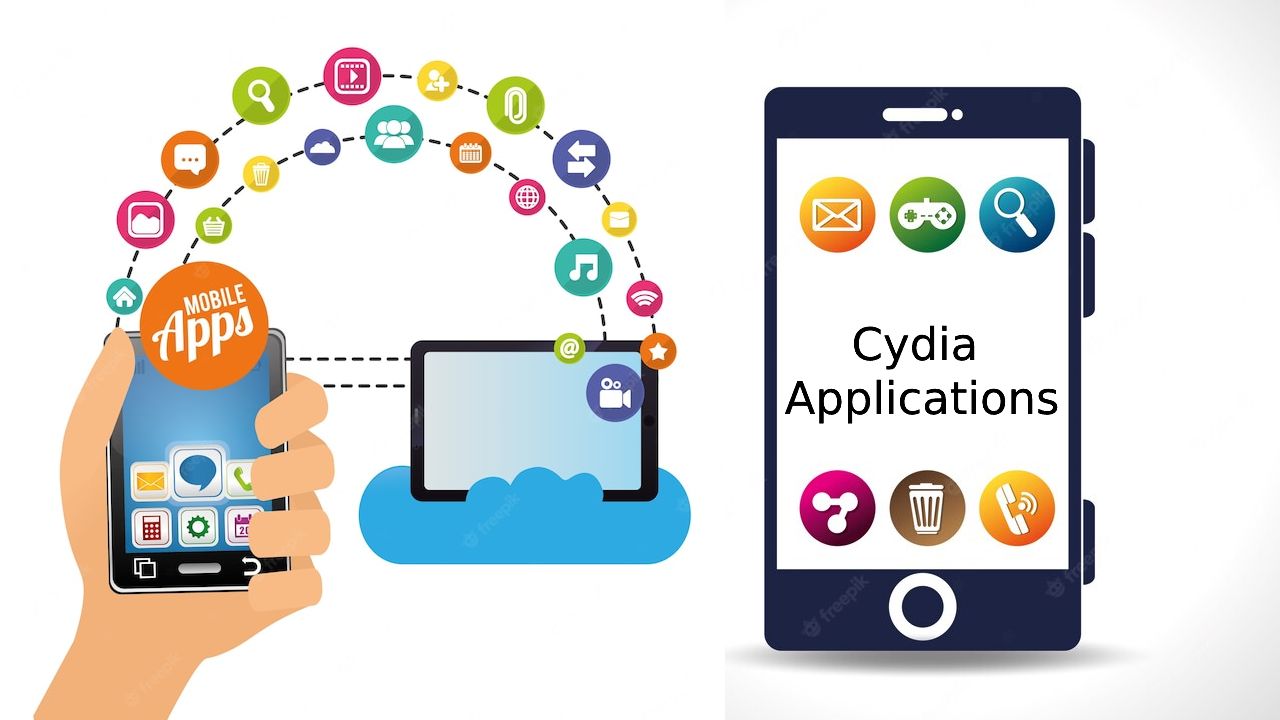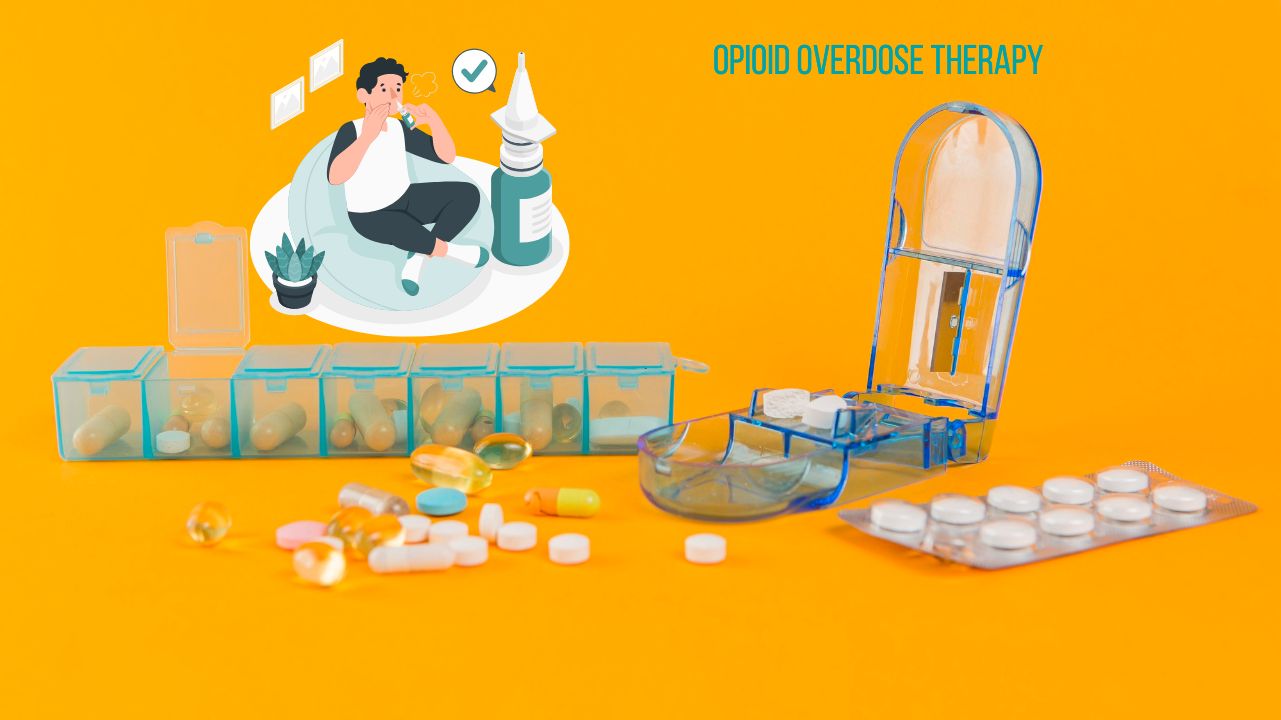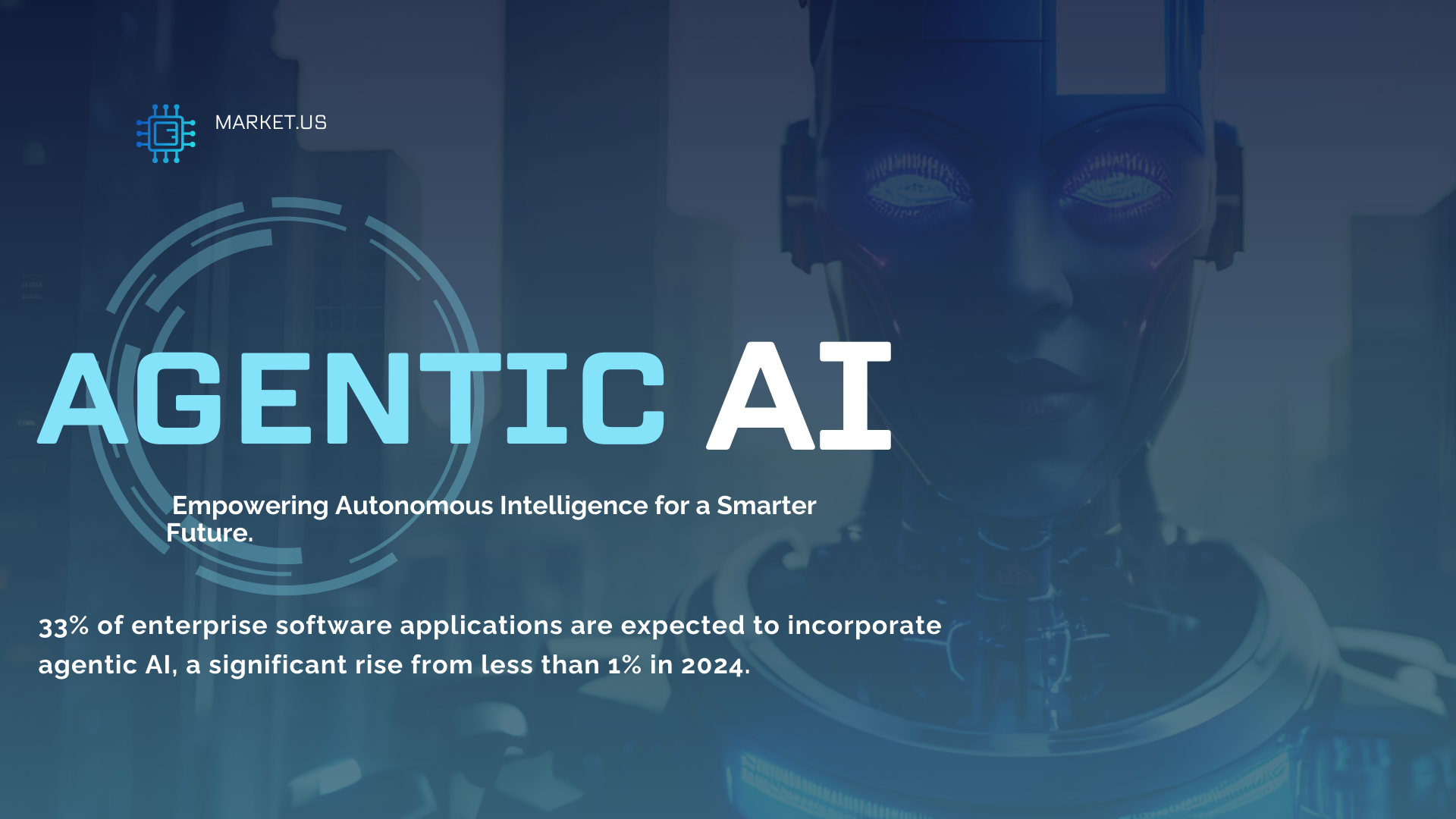WHAT WE HAVE ON THIS PAGE
- Editor’s Choice
- AI-Enabled Devices in Medical Fields
- AI-Driven Diagnostic Accuracy
- AI in Electronic Health Records (EHR) Optimization
- AI in Healthcare Market Growth Forecast
- Machine Learning in Predictive Analytics for Patient Outcomes
- AI-Powered Virtual Assistants and Chatbots in Patient Care
- Current Applications of AI in Healthcare: What Professionals Are Using Most
- Investment Trends and Market Size of AI in Healthcare
- AI Applications in Drug Discovery and Development
- Top AI Benefits That Make Patients Feel More Positive
- Ethical and Regulatory in Healthcare AI
- AI’s Impact on the Healthcare Workforce and Job Roles
- Public Comfort with AI in Healthcare Varies by Age
- Patient Perception and Trust in AI-Based Healthcare Solutions
- Regional Differences in AI Healthcare Implementation
- Trust in AI vs. Doctors for Diagnosing Health Conditions
- Recent Developments
- Conclusion
- Sources
In a sunlit hospital room in San Diego, a pediatrician glances at a screen not to read a chart but to receive a real-time, AI-generated diagnosis that considers thousands of similar cases. This is not fiction, it’s today’s reality. AI has become a silent partner in healthcare, revolutionizing diagnosis, treatment, and patient engagement with unprecedented speed and accuracy.
As we step into 2025, the fusion of artificial intelligence and healthcare isn’t just an evolution; it’s a redefinition. From clinical decision support systems to predictive analytics in emergency departments, AI is now central to both routine care and critical interventions.
Editor’s Choice
- $67.4 billion is the projected global AI healthcare market size in 2025.
- 89% of healthcare executives in 2025 report using AI in at least one clinical or operational function.
- AI is estimated to reduce administrative costs by $20 billion annually in the U.S. alone by 2025.
- 74% of U.S. hospitals use AI-powered diagnostic tools in radiology departments in 2025.
- 68% of drug discovery firms globally have integrated AI into their R&D processes as of 2025.
- 85% of patients surveyed in early 2025 are comfortable with AI-assisted health monitoring tools.
- 42% reduction in diagnostic errors in AI-supported hospitals was recorded in Q1 2025 compared to facilities without AI.
AI-Enabled Devices in Medical Fields
- Radiology leads overwhelmingly, accounting for 75.2% of all AI-enabled medical devices, showcasing the field’s early and dominant adoption of artificial intelligence.
- Cardiovascular applications come next, representing 10.9% of AI-enabled medical devices, signaling significant traction in heart-related diagnostics and monitoring.
- Hematology holds a modest share with 2.9%, reflecting growing use in blood analysis and pathology.
- Neurology sees 2.7% of AI device applications, aiding in brain imaging and neurological diagnostics.
- Clinical Chemistry contributes 1.2%, where AI helps in analyzing bodily fluids and chemical processes.
- General and Plastic Surgery shows 2.3%, possibly distinguishing between general surgical AI tools and aesthetic-focused applications.
- Microbiology accounts for 1.0%, supporting infection detection and microorganism classification through AI.
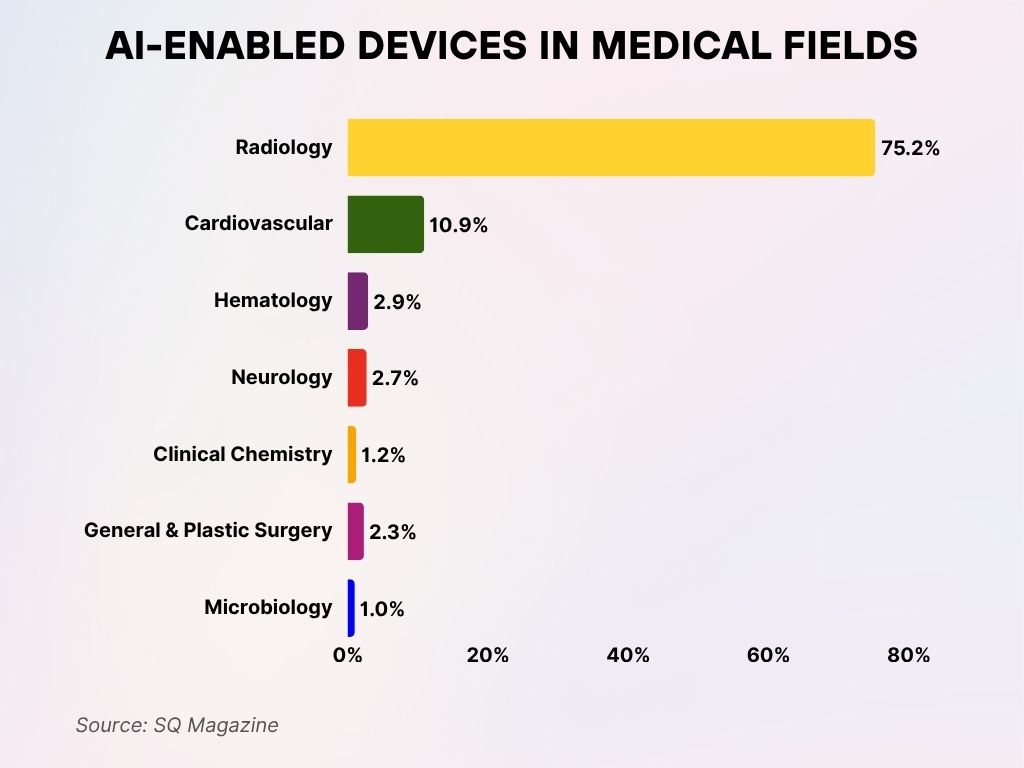
AI-Driven Diagnostic Accuracy
- In 2025, AI algorithms demonstrate a 96.3% accuracy rate in detecting diabetic retinopathy, outperforming human specialists by 12.5%.
- AI-assisted mammography now identifies early-stage breast cancer with a 92% sensitivity rate in 2025.
- A multi-center U.S. trial in 2025 found that AI diagnostic support reduced emergency room misdiagnoses by 37%.
- AI tools used in stroke diagnosis provide a 31-minute faster average decision time in 2025, which can critically improve outcomes.
- AI models applied to lung CT scans achieved 94.6% specificity in distinguishing benign from malignant nodules in 2025.
- 55% of U.S. hospitals use AI for sepsis prediction and intervention in 2025.
- AI systems reduced false positives in colorectal cancer screening by 46% across Medicare facilities in early 2025.
- A Johns Hopkins study in 2025 shows AI-enhanced diagnostic tools cut diagnostic delays for rare diseases by 23%.
- 81% of large academic hospitals now have AI-trained triage systems for emergency medicine in 2025.
- In rural clinics, AI platforms helped achieve a 32% rise in diagnostic concordance with urban centers in 2025.
AI in Electronic Health Records (EHR) Optimization
- 91% of U.S. health systems use AI to automate EHR documentation processes in 2025.
- AI has helped reduce physician time spent on charting by 43%, according to 2025 data from the AMA.
- Clinical note errors decreased by 29% in institutions using AI-driven transcription tools in 2025.
- In 2025, AI-driven systems are capable of flagging billing anomalies with 87% accuracy, enhancing compliance.
- 67% of health systems use AI to manage population health data from EHRs.
- AI-enabled EHR search tools reduced time spent retrieving patient histories by 55% in 2025.
- NLP-based AI modules improved patient documentation quality by 38% according to a multi-state review in 2025.
- A survey in Q2 2025 found 72% of physicians trust AI tools for summarizing complex case histories.
- A 35% drop in patient record duplication rates was recorded across AI-optimized EHR systems in 2025.
- AI tools now auto-recommend clinical trial matches based on EHR data, with 82% match precision in 2025.
AI in Healthcare Market Growth Forecast
- The global AI in healthcare market is projected to grow from $18.16 billion in 2024 to $72.85 billion by 2029.
- This growth reflects a compound annual growth rate (CAGR) of 31.7%, signaling rapid adoption across the industry.
- In 2025, the market is expected to reach $24.18 billion, continuing a strong upward trajectory.
- The market is set to more than triple in size over five years, indicating strong confidence in AI’s healthcare potential.
Year-by-year growth illustrates increasing investment and deployment of AI technologies in diagnostics, treatment, and patient management.
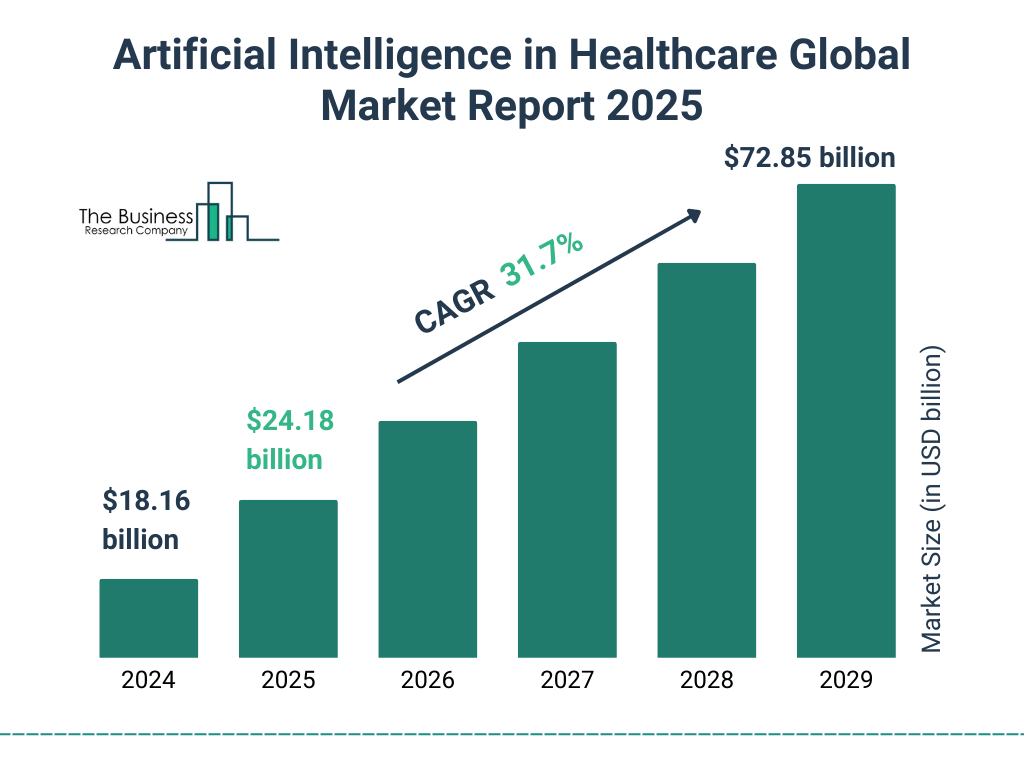
Machine Learning in Predictive Analytics for Patient Outcomes
- In 2025, machine learning (ML) platforms will be used by 64% of U.S. hospitals for predictive patient risk modeling.
- Predictive AI models helped reduce 30-day readmission rates by 18% across major hospital networks in 2025.
- 73% of oncology clinics will now use ML algorithms for personalized prognosis and recurrence prediction in 2025.
- ML tools improved the early prediction of cardiac arrest in ICUs by 28%, based on 2025 real-time monitoring data.
- AI systems now forecast hospital bed occupancy with 89.5% accuracy in 2025, aiding resource management.
- 47% of accountable care organizations in the U.S. will rely on ML for long-term chronic disease management plans in 2025.
- In 2025, AI-driven patient stratification models improved outcomes for type 2 diabetes by 21%.
- Predictive models using ML reduced delayed surgeries due to pre-op complications by 19% in 2025.
- Emergency departments using ML tools for triage prediction saw a 26-minute improvement in average wait time in 2025.
- 84% of healthcare CFOs report using ML for financial risk analytics and patient cost forecasting in 2025.
AI-Powered Virtual Assistants and Chatbots in Patient Care
- In 2025, 59% of healthcare providers will deploy AI-powered virtual assistants for appointment scheduling and triage.
- AI chatbots are responsible for resolving 67% of patient inquiries in less than 10 minutes by 2025.
- 76% of mental health platforms use conversational AI to deliver guided cognitive behavioral therapy (CBT) in 2025.
- AI health assistants helped increase patient follow-up adherence by 24% in remote care settings during 2025.
- A 38% reduction in nurse call center volume was reported across AI-integrated hospital systems in 2025.
- In 2025, 61% of primary care organizations will offer AI-driven symptom checkers integrated into patient portals.
- AI chatbots achieved an 82% patient satisfaction rate for first-contact support in Q1 2025.
- Virtual assistants now remind over 3.8 million patients daily in the U.S. to take medications, improving adherence by 19%.
- AI systems handled 40% of post-discharge care communication across integrated health systems in 2025.
- 48% of patients over age 60 used voice-based health AI tools in 2025.
Current Applications of AI in Healthcare: What Professionals Are Using Most
- 29% of healthcare professionals use clinical decision support tools, making it the most common application of AI in the field.
- 25% rely on predictive analytics and risk stratification, helping anticipate patient outcomes and manage resources effectively.
- 23% use AI for clinical workflow optimization and automation, streamlining repetitive tasks and improving efficiency.
- 19% turn to AI for treatment and therapy recommendations, assisting providers in creating personalized care plans.
- 16% adopt AI for diagnosis and treatment recommendations, enhancing diagnostic accuracy and clinical decision-making.
- 15% utilize AI in clinical documentation and dictation, reducing administrative workload and improving data accuracy.
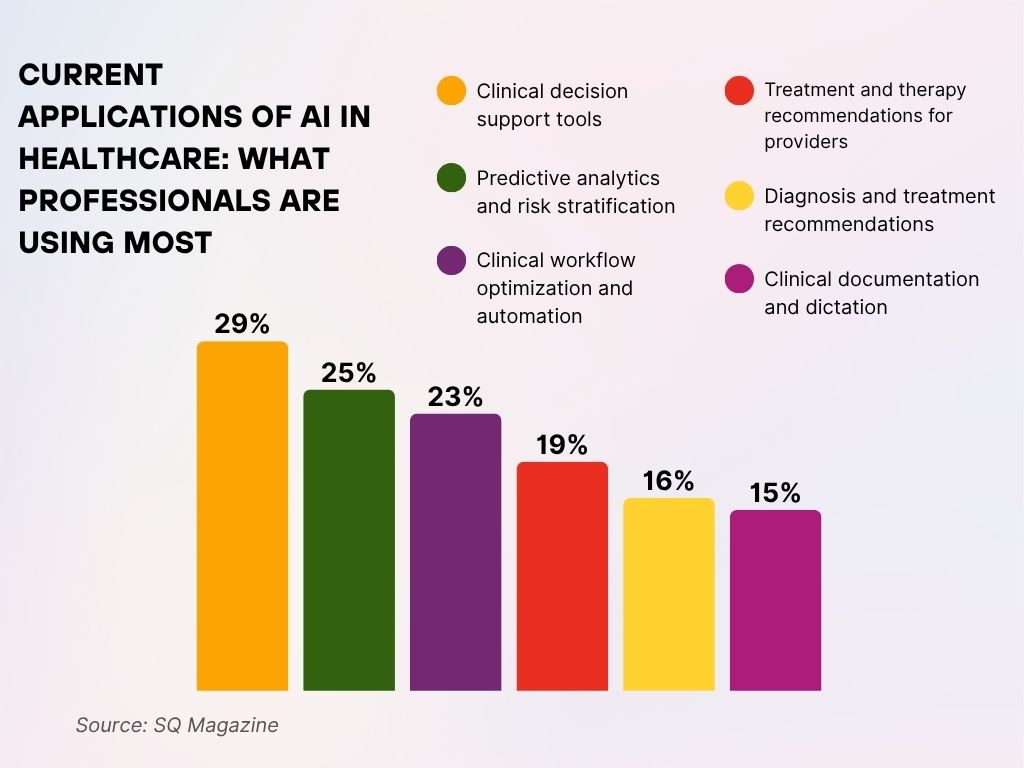
Investment Trends and Market Size of AI in Healthcare
- The global investment in AI health startups reached $23.8 billion in Q2 2025.
- $7.1 billion was directed toward AI-powered diagnostics companies in the first half of 2025 alone.
- In 2025, venture capital in AI drug discovery startups increased by 31% year-over-year.
- North America accounts for 42% of global AI healthcare investment volume in 2025, maintaining its lead.
- AI infrastructure upgrades in U.S. hospital systems saw an investment rise of 58% from 2023 to 2025.
- Private equity funding in AI-assisted imaging and radiology hit $3.2 billion globally in early 2025.
- 28% of new digital health companies founded in 2025 focus on integrating AI into clinical workflow tools.
- Government funding programs in the U.S. allocated $2.4 billion to healthcare AI innovation and testing in 2025.
- In Europe, €1.9 billion was committed to AI healthcare projects under the Horizon Europe initiative in 2025.
- The overall market valuation of AI in healthcare is expected to reach $67.4 billion globally by year-end 2025.
AI Applications in Drug Discovery and Development
- AI platforms reduced drug candidate screening times by 46% in 2025, accelerating preclinical pipelines.
- 68% of pharmaceutical companies globally will use AI for molecular property prediction in 2025.
- In 2025, AI-enabled drug repurposing projects identified 12 viable treatments for rare diseases in under 6 months.
- The average R&D cycle time was shortened by 15 months in AI-optimized pharma labs in 2025.
- Pfizer, Roche, and AstraZeneca all report using AI for high-throughput screening as of 2025.
- AI-assisted simulation tools helped reduce failure rates in early-phase clinical trials by 23% in 2025.
- Over 1,200 AI-based drug discovery tools are currently active in the global pharma landscape in 2025.
- The cost of bringing a new AI-discovered drug to market is $295 million on average in 2025.
- A biopharma consortium reported a 71% increase in hit-to-lead efficiency using deep learning models in 2025.
- In 2025, 42% of new orphan drug candidates emerged from AI-supported pipelines.
Top AI Benefits That Make Patients Feel More Positive
- 45% of patients feel more positive about AI if they know it would help improve their health.
- 43% are reassured if AI reduces the chance of mistakes being made in their care.
- 43% also value the benefit of being able to see a healthcare professional quicker due to AI.
- 39% are encouraged if AI allows doctors to spend more time with them during appointments.
- 36% would feel better about AI if it lowered their healthcare costs.
- 28% appreciate AI’s potential to let doctors be less distracted by note-taking during visits.
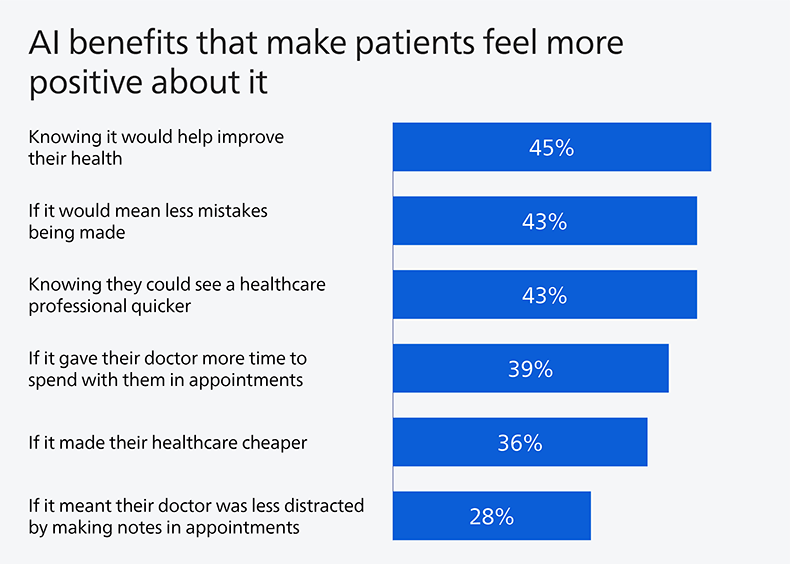
Ethical and Regulatory in Healthcare AI
- 73% of U.S. healthcare professionals in 2025 express concerns about AI decision transparency and explainability.
- In 2025, 18 countries have formalized regulatory frameworks specifically for healthcare AI.
- 41% of AI tools approved by the FDA in Q1 2025 required human-in-the-loop review mechanisms.
- HIPAA-aligned AI compliance platforms are now used by 62% of digital health firms in the U.S. in 2025.
- A 19% rise in patient consent opt-outs for AI data use was recorded in urban hospitals in 2025.
- 58% of patients surveyed in 2025 want access to the algorithms used in their AI-assisted diagnosis.
- 35% of AI bias incidents reported in healthcare in 2025 were related to demographic representation gaps in training data.
- Only 9% of current AI tools used in clinical settings were trained on datasets that included patients over age 75 in 2025.
- The EU’s MDR (Medical Device Regulation) compliance enforcement actions involving AI rose by 21% in the first half of 2025.
- 96% of healthcare AI vendors now conduct routine algorithm audits to ensure fairness and legal alignment as of 2025.
AI’s Impact on the Healthcare Workforce and Job Roles
- In 2025, 32% of healthcare organizations have redefined clinical roles to integrate AI support tools.
- AI automation has reduced medical transcription jobs by 49%, but added 22% more roles in data governance and AI operations in 2025.
- 71% of healthcare administrators report new job titles like “AI systems liaison” or “clinical algorithm curator” in 2025.
- AI assistance allows radiologists to handle 27% more cases per day on average in 2025.
- 45% of surveyed nurses say AI reduced their documentation burden significantly in 2025, increasing patient-facing time.
- Healthcare AI engineers saw a 34% salary growth between 2023 and 2025, reflecting rising demand.
- A study in 2025 revealed 63% of physicians trust AI insights in clinical decision-making when coupled with human oversight.
- 51% of teaching hospitals incorporated AI-specific courses into their medical education curricula by 2025.
- AI led to 17% efficiency gains in administrative staff workloads, including billing and compliance, in 2025.
- Labor unions in healthcare launched 12 new guidelines in 2025 to address worker protections in AI-influenced roles.
Public Comfort with AI in Healthcare Varies by Age
- 56% of adults aged 18–29 feel uncomfortable with AI in healthcare, while only 44% feel comfortable.
- Among those aged 30–49, 57% are uncomfortable, and 42% express comfort with AI use.
- The 50–64 age group shows increased skepticism, with 64% feeling uncomfortable and just 35% feeling comfortable.
- Seniors aged 65 and above mirror this sentiment, with 64% also uncomfortable and only 35% feeling comfortable.
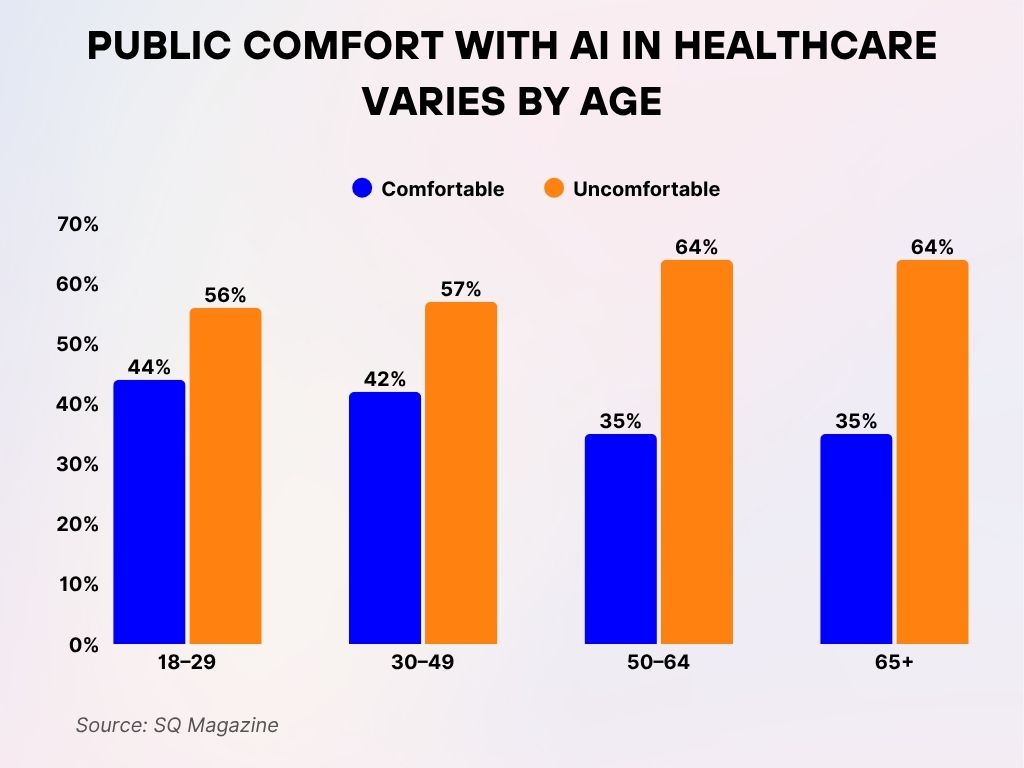
Patient Perception and Trust in AI-Based Healthcare Solutions
- In 2025, 85% of U.S. patients report a positive experience using AI-driven health tools.
- 58% of patients prefer hybrid AI-human care delivery models over human-only or AI-only services in 2025.
- 72% of individuals with chronic conditions feel AI tools improve their condition tracking and medication adherence in 2025.
- A national survey in 2025 found that 41% of patients hesitate to share sensitive data with AI systems due to privacy concerns.
- AI tools scored 4.3 out of 5 in average user satisfaction ratings across top health apps in 2025.
- 66% of millennials in the U.S. trust AI-powered virtual assistants for health questions in 2025, the highest among age groups.
- In 2025, 79% of patients believe AI reduces medical errors when used in collaboration with physicians.
- 37% of surveyed individuals cited AI transparency (i.e., how decisions are made) as a critical trust factor in 2025.
- 61% of patients using AI symptom checkers reported improved access to care in underserved regions in 2025.
- Despite adoption, 12% of patients still fear AI will replace doctors entirely, a belief unchanged since 2023.
Regional Differences in AI Healthcare Implementation
- North America leads in AI healthcare adoption in 2025, with 74% of hospitals using AI tools across at least three departments.
- Europe shows 57% implementation, driven by strong government AI policies and data privacy enforcement in 2025.
- In Asia-Pacific, healthcare AI usage surged by 48% in 2025, especially in diagnostics and remote care in India and South Korea.
- The Middle East has a 21% AI adoption rate in hospitals, with the UAE leading the region as of 2025.
- In Africa, mobile AI health platforms expanded by 36% in rural clinics in 2025, especially in Kenya and Ghana.
- Latin America saw a 29% increase in AI-assisted telehealth in 2025, driven by Brazil and Chile.
- Canada reported that 68% of its provincial hospitals now use AI in predictive analytics and imaging as of 2025.
- China surpassed the U.S. in AI patent filings in healthcare in 2025, with over 2,300 new filings in the year.
- AI implementation disparities within the EU persist; Scandinavia shows 80% AI usage while Eastern Europe lags at 34% in 2025.
- In 2025, the WHO initiated an AI equity program targeting 15 low-income countries to support AI adoption and training.
Trust in AI vs. Doctors for Diagnosing Health Conditions
- Among those who trust AI in diagnosis, only 4.6% would place most of their trust in AI alone, while 40.0% trust a combination of Doctors + AI, and 55.4% prefer Doctors only.
- For those who answered “Not Really” to trusting AI, 76.4% still trust Doctors only, while 20.9% trust Doctors + AI, and just 2.7% trust AI alone.
- Among respondents who outright do not trust AI, a significant 83.2% prefer Doctors only, with only 14.1% trusting Doctors + AI, and 2.7% trusting AI alone.
This shows that while AI is gaining some traction, trust is still heavily weighted toward human doctors, especially when making critical diagnostic decisions.
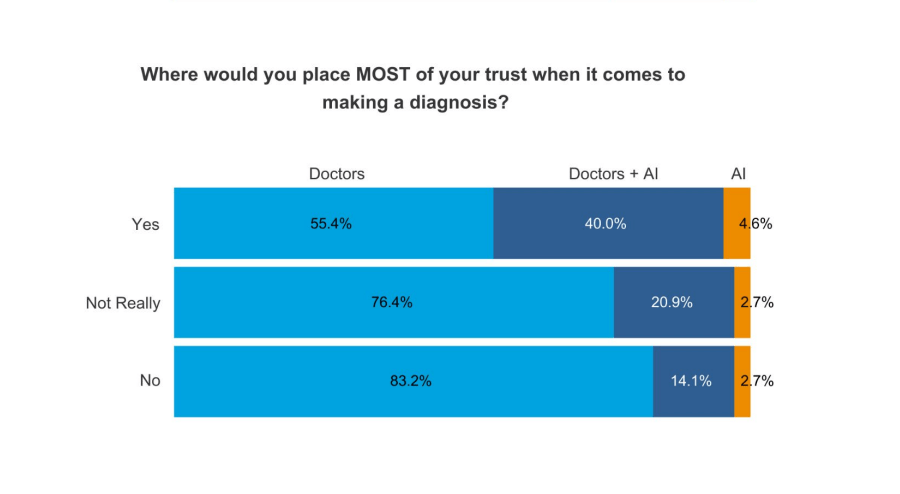
Recent Developments
- The FDA approved 22 new AI medical devices in Q1 and Q2 of 2025, focusing on diagnostics and decision support.
- Google Health’s MedLM model reached deployment in 180+ U.S. health networks by mid-2025.
- Microsoft Cloud for Healthcare will integrate real-time AI diagnostics with Azure-based EHRs in Q1 2025.
- IBM Watson Health was rebranded and relaunched in 2025 with a renewed focus on oncology and clinical decision platforms.
- A new AI standard, HL7-AI-FHIR, was introduced in 2025 for interoperability across health systems globally.
- Meta announced an AI-powered platform in 2025 aimed at mental health monitoring via wearable signals.
- Johns Hopkins and the Mayo Clinic co-developed a federated AI training framework in 2025 to preserve patient privacy.
- MIT researchers unveiled an explainable AI prototype in Q2 2025 that visualizes decision logic in diagnostics.
- The WHO 2025 Global AI Report flagged overuse of opaque AI models as a top ethical risk.
- In 2025, Stanford Medicine launched an AI-first primary care pilot clinic serving 20,000 patients with AI triage and workflows.
Conclusion
As 2025 unfolds, AI is no longer a futuristic promise; it’s a living, evolving element of healthcare. From radiology labs to rural telehealth cabins, it is reshaping how we diagnose, treat, and engage with care. The numbers tell a powerful story: improved outcomes, streamlined operations, and rising trust. Yet, this transformation comes with new ethical, regulatory, and workforce challenges. For healthcare to remain human at its core, the path forward must balance innovation with accountability, ensuring AI enhances rather than replaces the irreplaceable compassion of care.
Sources
- https://www.statista.com/topics/10011/ai-in-healthcare/
- https://www.weforum.org/stories/2025/03/ai-transforming-global-health/
- https://www.ncbi.nlm.nih.gov/books/NBK613808/
- https://www.statista.com/statistics/1615995/australia-comfort-with-ai-in-healthcare-by-use-case/
- https://www.forbes.com/councils/forbestechcouncil/2025/02/28/five-ai-innovations-that-will-redefine-healthcare-in-2025/
- https://yourstory.com/2025/04/ai-medicine-future-healthcare-happening
- https://www.who.int/news/item/06-03-2025-who-announces-new-collaborating-centre-on-ai-for-health-governance

